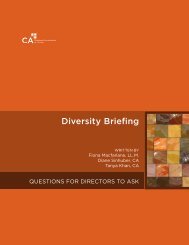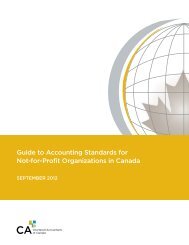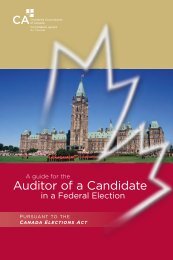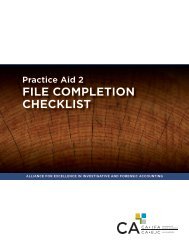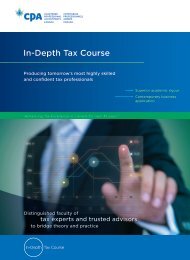20 Questions Directors of Not-for-Profit Organizations Should Ask ...
20 Questions Directors of Not-for-Profit Organizations Should Ask ...
20 Questions Directors of Not-for-Profit Organizations Should Ask ...
You also want an ePaper? Increase the reach of your titles
YUMPU automatically turns print PDFs into web optimized ePapers that Google loves.
Introduction<br />
<strong>Not</strong>-<strong>for</strong>-pr<strong>of</strong>it organizations must be trusted by<br />
their stakeholders and communities — both in the<br />
delivery <strong>of</strong> services and in their stewardship <strong>of</strong><br />
the organization’s assets, including the funding<br />
they receive from members, donors, governments<br />
and other sources. To earn and maintain this<br />
trust, organizations must be well governed by an<br />
effective board <strong>of</strong> directors. 1<br />
The board <strong>of</strong> directors is at the top <strong>of</strong> an<br />
organization’s structure. <strong>Directors</strong> <strong>of</strong> NPOs have a<br />
fiduciary role as stewards <strong>of</strong> the organization’s assets<br />
to approve funding, strategies, programs, activities,<br />
expenditures and other major decisions. The board<br />
is responsible <strong>for</strong> establishing the strategic and<br />
ethical directions <strong>of</strong> the organization. It recruits,<br />
compensates and evaluates the Chief Executive<br />
Officer (CEO) 2 and ensures a succession plan <strong>for</strong><br />
senior management. The board is also responsible<br />
<strong>for</strong> the oversight <strong>of</strong> strategy, risk management,<br />
internal controls, reporting and communications.<br />
In order to meet these responsibilities, boards need to<br />
have an effective system <strong>of</strong> recruitment, development<br />
and assessment. <strong>Directors</strong> 3 must collectively have the<br />
knowledge, skills and experience necessary to oversee<br />
and advise the management <strong>of</strong> the organization. They<br />
must be led effectively and work well together, but<br />
there should be a creative and healthy tension that<br />
comes from the constructive interaction <strong>of</strong> people<br />
with different backgrounds.<br />
Boards that demonstrate dedication to their own<br />
improvement will enhance the reputation and<br />
credibility <strong>of</strong> their organizations by setting the<br />
right tone at the top and sending a message to the<br />
organization and its stakeholders that the board<br />
takes its responsibilities seriously and holds itself<br />
accountable <strong>for</strong> achieving them.<br />
• identifying the skills, experiences and qualities<br />
that are desired in board members;<br />
• conducting a thorough, methodical and<br />
creative search process <strong>for</strong> directors; and<br />
• providing orientation, training and peer<br />
guidance to directors.<br />
Maintaining and enhancing the effectiveness <strong>of</strong> the<br />
board requires effective chairing <strong>of</strong> meetings and<br />
benefits from regular governance assessments that<br />
include:<br />
• involving board members, staff and other<br />
stakeholders as appropriate;<br />
• comparing per<strong>for</strong>mance against mandates,<br />
position descriptions and other per<strong>for</strong>mance<br />
criteria;<br />
• assessing board per<strong>for</strong>mance in key areas <strong>of</strong><br />
responsibility, including mission, programs,<br />
resources, asset and funding oversight and<br />
stewardship;<br />
• using surveys, interviews and other techniques<br />
that provide clear, actionable in<strong>for</strong>mation;<br />
• providing follow up feedback and reporting;<br />
• requiring action by the board, committees,<br />
chairs and individual directors to improve their<br />
per<strong>for</strong>mance;<br />
• incorporating results <strong>of</strong> assessments into the<br />
director nomination process in a transparent<br />
and fair manner; and<br />
• disclosing to members and other stakeholders<br />
that a robust and viable process exists <strong>for</strong><br />
director selection and governance assessment.<br />
Because NPOs are diverse, there is no one “right”<br />
way to select and develop directors and to assess<br />
governance. There are, however, a number <strong>of</strong> wellestablished<br />
principles and practices that may be<br />
adapted to the needs <strong>of</strong> NPOs.<br />
<strong>Not</strong>-<strong>for</strong>-pr<strong>of</strong>it governance processes are continuous<br />
and take leadership, time, commitment, creativity<br />
and experience. They involve a number <strong>of</strong> factors,<br />
beginning with:<br />
• understanding and defining in writing the<br />
mandates <strong>of</strong> the board and its committees and<br />
the position descriptions <strong>for</strong> directors and chairs;<br />
1<br />
In this document, the terms “Board <strong>of</strong> <strong>Directors</strong>” and “Board”<br />
are used <strong>for</strong> the body responsible <strong>for</strong> the governance <strong>of</strong> an<br />
organization. Other terms include “Council,” “Commission,” etc.<br />
2<br />
In this document, the term CEO (Chief Executive Officer) is<br />
used <strong>for</strong> the senior member <strong>of</strong> paid staff who is responsible<br />
<strong>for</strong> the operations <strong>of</strong> the organization and reports to Board.<br />
Other terms include “Executive Director,” “General Manager,”<br />
“President,” “Dean,” etc.<br />
3<br />
In this document, the term “Director” is used <strong>for</strong> a member <strong>of</strong> a<br />
board. Other terms include: “Trustee,” “Councilor,” “Commissioner,”<br />
“Governor,” etc.<br />
This document explores the challenge <strong>of</strong> building<br />
an effective NPO board from three perspectives:<br />
• the selection <strong>of</strong> directors;<br />
• the orientation and development <strong>of</strong> directors,<br />
and<br />
• the assessment <strong>of</strong> the per<strong>for</strong>mance <strong>of</strong> the<br />
board, board committees, board roles and<br />
individual directors.<br />
3








